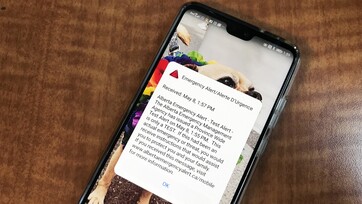Alberta Emergency Alert Test – November 17, 2021 at 1:55 p.m.
November 17 2021
Summary:
Albertans may ask questions on the alert test or emergency alerts in general. In Alberta, the emergency alert test will be issued on November 17 at 1:55 p.m. This is a nation-wide alert test on cell phones, television, radio and compatible wireless devices.
General messages on wireless public alerting:
- Alberta will issue a statement to media at 4 m. on November 16, 2021, social media posts through YourAlberta on November 15 and 17 and Minister will read a statement in the Legislature on Nov 16.
- Wireless public alerting is a national system that sends messages about life-threatening emergencies directly to smartphones in areas affected by an
- Tests are held twice a year: May 5 and November 17 in 2021. Alberta did not participate in the nation-wide test on May 5, 2021 to avoid confusion with Alberta’s emergency alert to inform people of COVID-19 restrictions issued on April 30
- The Natonal Public Alerting System or Alert Ready will test how it works on TV, radio, wireless, websites, social media, the Alberta Emergency Alert mobile app and directly to Albertans via compatible smart
- Tests are critical as they help us make sure that alerts work when we need them – helping to save lives and protect Albertans in the event of an
- The objective of Alert Ready is to ensure Albertans are aware of a potentially life-threatening
- Distributing alerts on multiple platforms helps ensure affected people receive this important information directly or are near someone else who has.
- Albertans are encouraged to download the AEA app: emergencyalert.alberta.ca.
- More information on wireless alerting and the test is online at alertready.ca
General questions and responses:
The alert sound is too loud/annoying/jarring/disturbing. What can I do?
- The distinctive sound at the beginning of an emergency alert on radio, television and compatible wireless devices is called the Canadian Alert Attention
- The emergency alert sound will usually play at the current volume setting on the wireless device, so if your wireless device is set to silent, no sound will accompany the emergency alert However, this can differ depending on your wireless device and in some instances the alert sound may override your user settings.
- Emergency alerts sent to compatible wireless devices will also cause the phone to
- The sound is designed to draw attention. If you receive an alert on your wireless device, it is because you are in an area affected by the alert. In an actual emergency, it is important to observe the instructions provided for your
- A compatible wireless device that is turned off will not receive an emergency alert. If/when the device is powered on, the emergency alert is still active and the user is still in the alert area, then the wireless device will display the alert. Cell phone service providers can help adjust user
- A compatible wireless device that is set to silent will display an emergency alert, but you might not hear the emergency alert
What is Alert Ready?
- Alert Ready is Canada’s emergency alerting system. It delivers critical and potentially life-saving alerts to Canadians through television, radio and LTE-connected and compatible wireless
- The Alert Ready system was developed with many partners, including federal, provincial and territorial emergency management officials, Environment and Climate Change Canada, Pelmorex, the broadcasting industry and wireless service providers. Together, these partners work to ensure Canadians receive alerts immediately and know when to take action to stay
How do I sign up to receive alerts on my mobile device?
- There is no sign-up or opt-in required. Emergency alerts will be automatically sent through broadcast channels such as television and radio, as well as to compatible, LTE-connected wireless
- Compatible wireless devices are:
- A wireless public alerting (WPA) compatible device, like a smartphone, capable of connecting to an LTE network (LTE is commonly referred to as “4G LTE”); and
- Equipped with the latest version of its operating software; and
- Connected to an LTE cellular network at the time the emergency alert is issued or joins the network while the alert is still
- To learn more about compatibility for Android and Apple devices, please visit the Device Compatibility section of Alert Ready website: https://www.alertready.ca/#faq.
- Specific compatibility questions related to your device are best answered by your wireless service provider (the company that provides your cell phone services).
How do I opt out of receiving alerts and alert tests?
- The Canadian Radio-television and Telecommunications Commission (CRTC) has mandated that all compatible wireless devices receive all relevant alerts and
- You can read more about the policy online at:
Some users will see a Presidential Alert (or similar banner in another language) on their phones, what is the reason?
- Wireless public alerts use an international standard. The broadcast channel used in the United States is called “Presidential Alert”. Governments and private sector partners have worked with Canadian wireless service providers to use the term “EMERGENCY ALERT / ALERTE D’URGENCE”.
- However, some phones pre-date this change, or were either purchased outside of Canada or manufactured to be compatible with the U.S. Wireless Emergency Alerts system. In these instances, those devices will use the American international standard and will display “Presidential Alert”, or another non-Canadian headline banner. For more information about your specific device, please contact your wireless
Why did my wireless device receive multiple messages for the same emergency alert?
- Check first that you have received several different alerts as opposed to a repeated alert. Additionally, check if another app on the device is notifying you of a single alert.
- If you are receiving repeated alerts of the same message, your device may be set with a REMINDER feature, this may cause the alert to repeat until you acknowledge it. This feature can be turned off following directions in your device’s User Guide. Your wireless service provider will also be able to provide assistance.
- You may also be receiving the alert through an app such as The Weather Network or Alberta Emergency Alert, which both distribute
Why did I receive an alert for a province I do not live in?
- If you are close to a provincial border, it is possible that you will receive an alert that is for the neighbouring province or
- At this time, we are unable to determine why wireless users who do not live near a provincial or territorial border receive an alert for another province or territory. We, along with our Alert Ready partners, are working together to determine the
How are test times established? Why are they at different times?
- Test times are decided by provincial and territorial
- The CRTC has approved a test alert schedule of two public awareness tests per Tests of the Alert Ready system take place each year during Emergency Preparedness Week in May and in November. Given the COVID-19 pandemic, the test did not take place in May and November 2020 and May 2021.
Background:
Wireless public alerting and the National Public Alerting System (NPAS)
- Federal and provincial governments, in collaboration with industry partners, launched the National Public Alerting System (NPAS) in 2018, through the adoption of the “Alert Ready”
- Prior to this, Alberta had its own alerting system called Alberta Emergency Alert (AEA), which continues to work as part of the new
- Other provinces and territories use the “Alert Ready” wireless public alerting system that was activated in April Alert Ready and Alberta Emergency Alert are complementary systems.
- The Alert Ready system was developed in partnership with federal, provincial and territorial emergency management officials, Environment and Climate Change Canada, The Weather Network, the broadcasting industry and wireless service
- More information on wireless alerting: alertready.ca/
Alberta Emergency Alert
- Alberta created the first emergency alert system in Canada in 1993. The system continues to evolve with changing consumer needs and information technology
- Alberta’s alerting system provides information about developing and immediate
- Alerts are distributed through radio, television, government and partner websites, Twitter, Facebook and the Alberta Emergency Alert
- Alberta Emergency Alert connects to the Pelmorex-operated Alert Ready system to pass only the most serious alerts to Wireless Service Providers (for cell phones).
- The Alberta Emergency Management Agency maintains the Alberta Emergency Alert for use by municipalities, First Nations, Environment and Climate Change Canada and other emergency management stakeholders.
- Each municipality and First Nation has staff to send alerts for their
- They are also responsible for updating messages or cancelling the
- There are approximately 775 users in 400 communities across Alberta trained to issue If needed, the Government of Alberta can issue or revise alerts on behalf of a community.
- Alberta Emergency Alert will continue to provide information on developing emergencies and serious alerts for regions in Alberta, including maps and links to resources
- Albertans are encouraged to download the Alberta Emergency Alert app: emergencyalert.alberta.ca
Annual Alert Tests
- Test alerts are issued nation-wide through the NPAS twice a year: May 5 and November 17 in Alberta did not participate in the test on May 5, 2021, to avoid confusion with Alberta’s alert to inform people of COVID-19 restrictions issued on April 30.
- The test alert only works if the receiving cell phone or mobile app is compatible, on the LTE 4G network, turned on, and connected to Wi-Fi.
- Government of Canada laws require that all compatible wireless devices receive all relevant alerts; therefore, it is not possible to opt out of receiving
- Radio and TV broadcasters also have to transmit the most serious alerts as a condition of their operating license.
Test schedule for Canada is online at https://www.alertready.ca/testing-schedule/
TESTING SCHEDULE
|
PROVINCE O R TERRITO RY |
DATE |
TIM E |
|
Alberta (info) |
Wednesday, November 17, 2021 |
1:55 PM MST |
|
British Columbia (info) |
Wednesday, November 17, 2021 |
1:55 PM PST |
|
Manitoba (info) |
Wednesday, November 17, 2021 |
1:55 PM CST |
|
New Brunswick (info) |
Wednesday, November 17, 2021 |
10:55 AM AST |
|
Newfoundland and Labrador (info) |
Wednesday, November 17, 2021 |
10:55 AM NST |
|
Northwest Territories (info) |
Wednesday, November 17, 2021 |
9:55 AM MST |
|
Nova Scotia (info) |
Wednesday, November 17, 2021 |
1:55 PM AST |
|
Nunavut (info) |
Wednesday, November 17, 2021 |
2:00 PM EST |
|
Ontario (info) |
Wednesday, November 17, 2021 |
12:55 PM EST |
|
Prince Edward Island (info) |
Wednesday, November 17, 2021 |
12:55 PM AST |
|
Quebec (info) |
Wednesday, November 17, 2021 |
1:55 PM EST |
|
Saskatchewan (info) |
Wednesday, November 17, 2021 |
1:55 PM CST |
|
Yukon (info) |
Wednesday, November 17, 2021 |
1:55 PM PDT |


